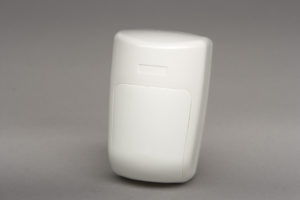Resolving Security
Remember them? That’s the proud family that’s making it’s way out into the world right now, plying it’s trade as the best security/automation system in North America right now. It’s moving with you, all over Canada. Into your apartments, townhouses, homes and businesses.
We explored it’s basics here.
Most important, it’s making sure you’are secure no matter where or how you live. Plus, it looks good doing it.
We’ve covered the control panel in all it’s picturesque glory, and will do so again as we get into home automation. Right now I kind of feel like the rest of the family should get some attention here.
This is just the beginning. It’s going to take a few submissions to do justice to the system and it’s families real breadth. But we gotta start somewhere, so I’m going to go all basic on you.
Yep! That’s a door contact.
Pretty simple. Magnet, transmitter. If you have an alarm system, or you have ever had an alarm system, you’ve had this or something like this.
The contacts don’t have to be restricted to doors though. These puppies can work on windows, or anything that you don’t want to have opened while you’re not around.
Unless it’s your Garage Door
For garage doors, the Helix uses this. This is called a tilt sensor.
There’s no magnet. There’s no gap. There’s nothing mounted to the floor you can run over. This sensor mounts to the top of your garage door, and is triggered as the door folds up. Anything over a 30 degree tilt will give the same feedback as if someone had opened your front door.
Garage doors aren’t the only application for a tilt sensor, but they are the most common. Really, adhering them to anything you are concerned about walking away is a good idea.
Don’t confuse them with vibration sensors. We’ll get to those later.
Sticking to the Old School
Your motion detector. You put it on the wall, it watches for body heat in motion.
These particular ones are what we call “pet friendly”. The devices themselves will allow for a pet up to 85 lbs, or two pets 60 lbs or less. As with all “pet friendly” motion detectors, the pet needs to remain near the floor in the areas where the detectors are looking. Your standard 90 degree field of view applies here, with a 44 foot range.
Edit: That means no birds and no flying ponies. Especially not flying ponies. Those are the WORST.
These motions operate on a dual sensor, reducing false alarm probabilities from things like air conditioners and heating. The concerns of your motions being set off by a blowing curtain are greatly reduced.
For Those With a Lot of Windows
Or just big windows. It’s a glass break detector. These are designed to pick up the sound and vibration of breaking glass. They work on frequency and decibel level.
The major difference between glass break detectors and motion detectors is that glass break detectors listen, and motion detectors watch. Which one is more appropriate for you? We’ll go there. Actually these two devices make for some really good debate in the security alarm industry.
And That’s Your Basic Alarm System
Almost everything the standard Home, Apartment of Business will need to secure it from the regular, everyday smash-and-grabber.
It’s not everything, though. Not by a long shot. There are some more complex devices I’m really excited to get into. Versions of them have been around for a while, but here we get a chance to explore them a little more and explain what they do for you.
As usual, our Facebook page is always open to take your questions. If that’s not your thing, use the question submission form on the right. We’ll be back in touch as soon as we can be.
Oh, and by the way…. here’s a link to the demo. You’ll want to pay a visit to us to get the full experience, but here are the basics;
http://resolutionproducts.com/smartlink-demo/






No comments yet.